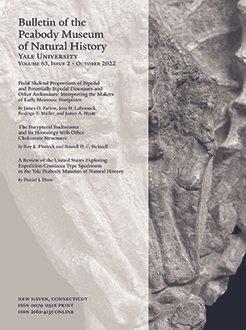Dinosaur footprints often occur in Late Triassic–Early Jurassic continental sedimentary rocks. While many such tracks can readily be associated with the kinds of dinosaurs that made them, the makers of some footprints have been controversial. Large tridactyl (three-toed) footprints of the ichnogenus Eubrontes are thought by most paleontologists to have been made by theropod dinosaurs, but some workers think their makers were basal sauropodomorph (“prosauropod”) dinosaurs. The four-toed footprint Otozoum is usually interpreted as a prosauropod print, but some workers instead attribute it to an ornithischian (basal thyreophoran) dinosaur or even a pseudosuchian archosaur. These issues prompted us to do a new study of the proportions of the hindfeet of bipedal and potentially bipedal dinosaurs and other archosaurs, adding new measurements to previously available data. Foot skeletons of theropod dinosaurs differ from those of bipedal ornithischian dinosaurs in having relatively longer phalanges from the middle portions of toes, narrower phalanges, relatively shorter unguals, and a relatively shorter inner toe (digit I—but some members of both groups lose digit I altogether). Theropod feet differ from feet of prosauropods in having slightly narrower phalanges, relatively shorter unguals, and a relatively shorter digit I, but some smaller basal sauropodomorphs are harder to distinguish from theropods in these features. Feet of small to medium-sized ornithischians that retain digit I are very similar to those of most basal sauropodomorphs and also some pseudosuchians. Our results suggest that most (but perhaps not all) morphologically well-preserved Eubrontes are more likely to have been made by theropods than bipedal sauropodomorphs. It is more difficult to determine the most likely maker(s) of Otozoum.
How to translate text using browser tools
30 September 2022
Pedal Skeletal Proportions of Bipedal and Potentially Bipedal Dinosaurs and Other Archosaurs: Interpreting the Makers of Early Mesozoic Footprints
James O. Farlow,
Jens N. Lallensack,
Rodrigo T. Müller,
James A. Hyatt
ACCESS THE FULL ARTICLE
Eubrontes
Evazoum
Otozoum
Vertebrate ichnology






